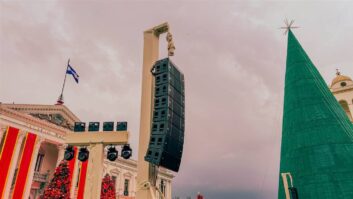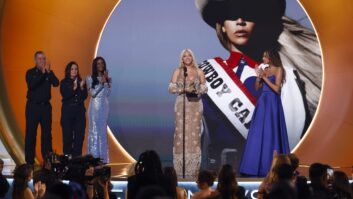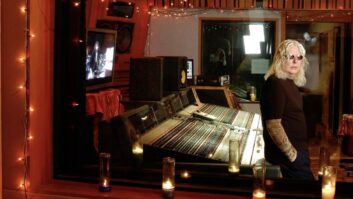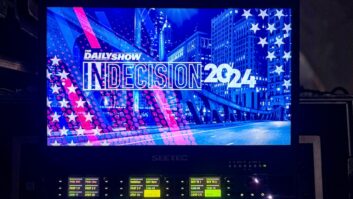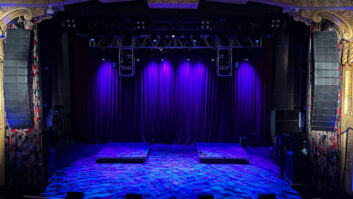“There’s probably no indoor theater this big in the world hosting live opera,” says Allan Naplan, referring to the 12,000-plus crowd gathered for the fourth annual Opera in the Park held in Madison, Wis. — based Garner Park. The event (held July 16, 2005) was a smashing success for the Madison Opera, a company Naplan presides over as general director.
Bag End mains and delay towers handle the 12,000-plus audience.
Featuring top-name talent from around the globe, Opera in the Park offers everything from the triumphant tones of “Nessun Dorma” from Giacomo Puccini’s Turandot to the ensemble of Alexander Borodin’s exquisite Polovtsian Dances. A major challenge was determining how to best bring even, intelligible coverage to the huge open-air crowd without losing the natural sound vital to the music’s character. Equally daunting was the task of building an acoustical environment that would ease the transition to performing outdoors for an orchestra, choir and featured vocalists unaccustomed to working in large, open spaces, not to mention with sound reinforcement.
Jonathan Lipp at the FOH position
The Madison Opera tapped the volunteer resources of Bag End Loudspeakers and nearby Full Compass Systems in Middleton, Wis. Collaborating on a minimalist approach to a job mindful of both onstage and audience needs, the companies worked together to develop a sonic blueprint using only a smattering of premium mics and an all Bag End house P.A. system.
“Sound reinforcement can be brought to a large outdoor concert that approximates the aural aesthetics of an indoor hall,” says Full Compass founder/front-of-house engineer Jonathan Lipp. “Contrary to what you may think, less is actually more in this application when it comes to the number of microphones used. Using a lot of mics in a situation like this, it’s nearly impossible to obtain a proper balance. For example, if you have 15 violins in the orchestra and you use 15 mics — or even 10 — it would be impossible to re-create the blend you’d get by using only one over the whole section. Some of the violins would be too loud and others would be too soft.”
Practicing what he preaches, Lipp came to this year’s Opera in the Park with only 10 mics to cover the 55-piece Madison Symphony Orchestra, 63-piece Madison Opera Chorus section and five vocalists out front. For the orchestra and choir, a pair of Shure KSM44s were mounted in a center/forward position over the violins and violas. Using the mics in figure-8 mode, he experimented with a number of placements until he obtained the right sound. Three more backline KSM44s contributed to the mix, as did a Neumann KM120 on harp. Out front, the vocalists stood in front of four KSM44s stand-mounted low and tilted slightly to the rear.
Mixing from a 16-channel Yamaha 01V96 digital console, Bag End’s Henry Heine confided that once he and Lipp had set up and tuned the system, there was little to do out front when the lights came up and the musicians took the stage. “Basically, you just have to keep an eye out for when the vocalists come onstage and turn the appropriate mic on,” Heine notes. “Other than a little reverb coming from the Yamaha mixer, we didn’t use any processing or effects. With three Crystal loudspeaker enclosures per side, we delivered a solid stereo mix for the first 140 feet. Beyond that, self-powered P-Crystal enclosures delayed in mono atop towers took over for the rest of the area of coverage.”
With the house arrays buttressed at the low end by a pair of Quartz subwoofers, monitoring for the vocalists was handled by Sapphire wedges. Filling in with added reverb and support, a pair of TA6000 cabinets was hung along a middle truss above the orchestra and choir. “These provided a nicer feeling for the performers,” Heine remarks. “That’s the true purpose of those upstage monitors: to furnish a connection with the front. Regardless of what we do, we’ll never be able to give them the full effect of being indoors in a concert hall. But with a little thought and planning, we’ve at least fooled them into thinking they are in some kind of indoor acoustic environment.”
“Distilled to its bare essence, the real function of the sound system is to simply extend the reach of the performance,” Lipp adds. “There’s no exotic mixing, no complicated cues to follow. We just use quality components from the mics to the speakers and try to make it as transparent as possible. The rest happens onstage.”
Nick Russell is a Chicago-based writer.
